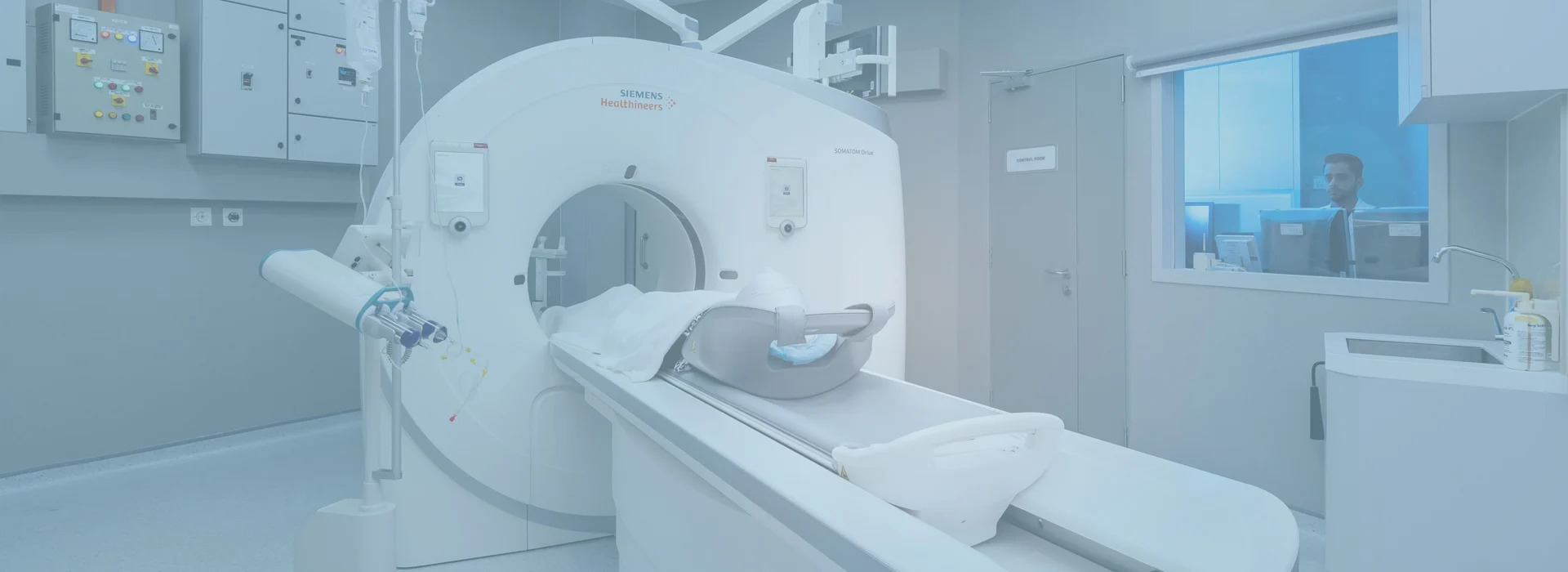
06 Oct Living with Chronic Migraines: Symptoms, Treatments & When to Seek Help
Living with Chronic Migraines: Symptoms, Treatments & When to Seek Help
By Island Hospital | October 6, 2025 10:34:09 AM
The meeting is in full swing. Deadlines are tight, ideas are flying around the room, and then it happens. A familiar, unwelcome throb begins behind your eye, pulsing with each heartbeat. You’ve felt it before, yet somehow, it always feels different — unpredictable, and never invited.
Without warning, the pain sharpens into a searing ache. The lights above seem too bright, your stomach twists in discomfort, and every voice around you fades into a distant, muffled blur. The rest of the meeting becomes a battle, not against the agenda, but against the pain in your head.
For some, migraines strike only now and then. For others, they come relentlessly, appearing almost every day, stealing time, energy, and focus. This is chronic migraine, a neurological disorder that can disrupt careers, strain relationships, and take a toll on mental health.
Chronic migraine is far from “just another bad headache”, but there is still hope. With the right diagnosis and a personalised treatment plan, it’s possible to reduce the frequency and severity of attacks and regain control over your days.
That’s exactly why we’re here. In this guide, we’ll unpack what chronic migraine is, how to recognise it, what causes it, and the treatment options and lifestyle strategies that can help you finally break free.
What is Chronic Migraine?
Migraines are not just headaches: they’re a complex neurological condition that can trigger intense, throbbing pain along with a range of other symptoms. While an occasional migraine can be disruptive, chronic migraine is in a different category altogether.
Chronic migraine occurs when you experience frequent or long-lasting episodes of headaches and migraines.
It is typically defined as having headaches on 15 or more days a month, for at least three months. With at least 8 of those days, showing migraine features such as moderate-to-severe throbbing pain, sensitivity to light or sound, and nausea.
In other words, chronic migraine isn’t a one-off episode; it’s a recurring condition that can feel like it’s taking over your life. Without proper diagnosis and treatment, it can progress into “chronification”, where migraine attacks become increasingly frequent and harder to control.
Symptoms of Chronic Migraine
Chronic migraine symptoms vary from person to person, but common signs include:
- Throbbing or pulsating head pain (often on one side but sometimes both)
- Sensitivity to light, sound, or smell
- Nausea and/or vomiting
- Visual disturbances (aura, flashing lights, zig-zag lines, or blind spots)
- Neck stiffness or pain
- Difficulty concentrating or finding words
- Extreme fatigue (irritability, low mood, or anxiety before or after an attack)
- Mood changes before, during, or after an attack
Some people notice early warning signs hours or even days before an attack (known as the prodrome), such as:
- Unusual tiredness or frequent yawning
- Food cravings or increased thirst
- Changes in mood
- Needing to urinate more often
For certain individuals, migraines also occur with aura — temporary neurological symptoms that appear before or during the headache, such as:
- Visual disturbances (flashing lights, zig-zag patterns, or blind spots)
- Numbness or tingling in the face or hands
- Dizziness
- Difficulty speaking
Aura symptoms usually last less than an hour, and not everyone with chronic migraine experiences them. In rare cases, aura can occur without the headache, sometimes called a “silent migraine.”
Episodic vs. Chronic Migraine
Around 14% of the global population experiences migraine each year, making it the second leading contributor to the worldwide burden of neurological disorders. But not all migraines are the same; yours may fall into either the episodic migraine or chronic migraine category.
| Episodic Migraine | Chronic Migraine | |
|---|---|---|
| Headache Days per Month | Fewer than 15 | 15 or more |
| Migraine Days | Less than 8 | 8 or more |
| Impact on Daily Life | Disruptive but often manageable with acute treatment | Significant disruption to work, relationships, and quality of life |
| Risk of Progression | May progress to chronic if triggers are uncontrolled or medication is overused | High — requires long-term management and preventive treatment |
Think a brain tumour diagnosis is always a death sentence? Think again. Our in-depth guide explores the types and symptoms of brain tumours, how they’re diagnosed and treated, and ways to maintain your quality of life throughout your journey.
Causes of Chronic Migraine
The exact cause of chronic migraine isn’t fully understood, but it’s believed to involve a combination of neurological changes in the brain, abnormal pain signalling, and a sensitivity to certain triggers.
Over time, repeated migraine attacks can make the brain more reactive, increasing the risk of “chronification”, where occasional migraines become frequent and harder to control.
Possible Factors Behind Chronic Migraine
Some people find certain triggers that can cause migraines, such as:
- Genetics
Migraines often run in families, suggesting a hereditary component.
- Nervous system changes
Overactive pain pathways in the brain and brainstem may amplify pain signals.
- Hormonal changes
Fluctuations in oestrogen levels before or during menstrual periods, pregnancy, or menopause. Hormonal medicines such as oral contraceptives can worsen migraines for some, but improve them for others.
- Overuse of acute medication
Regularly using painkillers or migraine medicines more than recommended can lead to “medication overuse headache”, which can feed into chronic migraine.
- Underlying health conditions
Issues like anxiety, stress, depression, sleep disorders, and high blood pressure can make migraines more persistent.
- Lifestyle and environmental triggers
Stress, irregular sleep, dehydration, skipped meals, bright lights, loud noises, strong smells, weather changes, and certain foods or drinks (such as alcohol, caffeine, or processed foods).
- Alcohol and caffeine
Alcohol (especially wine) and excessive caffeine can provoke migraines.
- Sensory stimuli
Bright or flashing lights, loud noises, or strong smells (perfume, paint thinner, second-hand smoke) can set off attacks.
Risk Factors and Complications of Chronic Migraine
While anyone can experience a migraine, certain factors can make you more likely to develop chronic migraine or cause your symptoms to worsen over time. Left unmanaged, chronic migraine can lead to complications that affect not only your physical health but also your emotional well-being and daily life.
Risk Factors
- Family history – Having close relatives with migraines increases your risk.
- Gender – Women are more likely to experience migraines, partly due to hormonal influences.
- Age – Migraines often begin during adolescence or early adulthood, and the risk of chronification may increase over time.
- Frequent episodic migraines – Having migraines often (but not yet chronic) can progress into chronic migraine if triggers aren’t well managed.
- Medication overuse – Overusing pain relief medicines, including over-the-counter options, can worsen headaches over time.
- Underlying health conditions – Anxiety, depression, sleep disorders, and obesity are linked to more frequent attacks.
Complications
If not properly treated, chronic migraine can lead to:
- Reduced quality of life – Frequent pain can interfere with work, family life, and social activities.
- Mental health challenges – Higher rates of anxiety and depression are seen in those with chronic migraine.
- Medication overuse headache – A cycle where the very medicines taken to relieve pain actually make headaches more frequent.
- Increased sensitivity – Over time, the brain may become more reactive to triggers, making attacks harder to control.
When to See a Doctor?
While chronic migraine is usually a persistent condition rather than a sudden emergency, there are important signs where you should seek medical attention, sometimes urgently.
Red Flag Symptoms
Call emergency services or make your way to the nearest hospital immediately if you or someone you know experiences:
- A headache that came on suddenly and is extremely painful
- Confusion, loss of vision, sudden weakness, or difficulty speaking or remembering things
- High fever, stiff neck, rash, or severe headache after a head injury
When to Seek Medical Attention Promptly?
Make an appointment with your doctor if:
- Headaches persist or get worse despite over-the-counter painkillers
- Pain is interfering with work, relationships, or daily life
- Your aura lasts longer than an hour, which is unusual and may need further evaluation
Emergency Care in Malaysia
If any of these red flags occur, call 999 or 112 for ambulance assistance. In Penang, Island Hospital’s Emergency Department is open 24/7 and fully equipped for comprehensive neurology and neurosurgery emergencies, ensuring you receive prompt assessment and intervention for migraine-related emergencies.
How Neurologists Diagnose Chronic Migraine
A chronic migraine diagnosis is more than just counting how many headaches you get in a month: it’s about understanding your full health picture.
1. Detailed Medical History
Your doctor will start by asking about:
- How often your headaches occur and how long they last
- The nature of your pain (throbbing, sharp, dull, etc.)
- Associated symptoms such as nausea, sensitivity to light or sound, and aura
- Your personal and family history of migraine or other neurological conditions
- Any medications you are taking, including over-the-counter remedies
A headache diary can be incredibly useful here, helping you and your doctor identify patterns and possible triggers.
2. Physical and Neurological Examination
This involves checking:
- Reflexes, muscle strength, and coordination
- Vision and eye movements
- Sensory function and balance
The goal is to rule out other possible causes of your headaches.
3. Diagnostic Tests (If Needed)
There is no specific test that can confirm chronic migraine. Diagnosis is based on your medical history, your symptom pattern, and a neurological examination.
However, if your doctor suspects another condition may be causing your headaches, such as a brain tumour, stroke, or structural issue, especially if your symptoms are unusual, severe, or have changed recently they may recommend tests to rule out other causes.
These can include:
- MRI scans – produce detailed images of your brain and blood vessels to check for structural abnormalities, tumours, or signs of stroke.
- CT scans – use X-rays to detect bleeding, swelling, or other acute changes in the brain.
- Blood tests – help identify infections, inflammation, or other underlying medical issues that can cause or mimic migraine symptoms.
In some cases, other specialised tests may be needed, such as eye examinations, lumbar puncture (spinal tap), or EEG (to measure brain activity), depending on your symptoms.
Your healthcare provider will explain exactly why a test is needed, what it involves, and what they’re looking for, so you can feel informed and reassured at every step.
Worried about stroke symptoms or how fast treatment matters? This in-depth article explains how strokes happen, what critical warning signs to look out for, and why acting quickly can dramatically change outcomes.
Treatment and Management
Managing chronic migraine isn’t about finding one miracle cure, it’s about combining treatments, lifestyle strategies, and medical support to reduce both the frequency and severity of attacks.
1. Acute Treatments
Acute (or abortive) treatments are taken at the start of a migraine attack to relieve pain and other symptoms.
- Over-the-counter painkillers (paracetamol, NSAIDs)
- Triptans (sumatriptan, rizatriptan)
- Gepants (ubrogepant, rimegepant)
- Anti-nausea medicines (metoclopramide, prochlorperazine)
Suitable for: People who have migraine attacks but are still able to manage daily life between them.
Not suitable for: Those with frequent attacks where medication overuse is a risk; people with certain heart or blood vessel conditions may not be able to take triptans.
2. Preventive (Prophylactic) Treatments
Preventive treatments aim to reduce how often attacks happen. These are taken regularly, even when you’re not having a migraine.
- Anti-seizure medicines (topiramate, valproate)
- Beta blockers (propranolol)
- Antidepressants (amitriptyline)
- CGRP inhibitors (erenumab, fremanezumab)
- Botulinum toxin type A (Botox) injections
Suitable for: People with frequent or disabling attacks (e.g., 15+ headache days a month).
Not suitable for: Those with mild or rare migraines; some medications are avoided in pregnancy or certain health conditions.
3. Non-drug Options
These treatments can be used alone or alongside medication:
- Neuromodulation devices (e.g., single-pulse transcranial magnetic stimulation)
- Acupuncture
- Biofeedback therapy
- Physiotherapy for neck and posture-related tension
Suitable for: People who prefer drug-free options, can’t tolerate medications, or want to boost the effectiveness of other treatments.
4. Lifestyle and Trigger Management
Small changes in daily habits can make a big difference:
- Keep a headache diary to spot triggers
- Eat regular, balanced meals
- Limit caffeine and alcohol
- Get consistent sleep (avoid too much or too little)
- Manage stress with mindfulness, yoga, or breathing exercises
- Stay hydrated
5. A Holistic, Individualised Plan
There’s no one-size-fits-all solution for chronic migraine. Your best treatment might be a combination, for example, Botox every 3 months, triptans for acute attacks, and lifestyle changes to avoid triggers.
Thinking about migraine treatment?
Our neurology and neurosurgery care team at Island Hospital is here to guide you every step of the way, from diagnosis to treatment, and even the emotional support you need to regain control of your life.
Treatment Overview Table
| Treatment Type | Examples | When Suitable | When Not Suitable |
|---|---|---|---|
| Acute | NSAIDs, triptans, gepants | Occasional attacks; fast relief needed | Frequent use (risk of medication overuse), certain heart conditions |
| Preventive | Topiramate, beta blockers, Botox, CGRP inhibitors | 15+ headache days/month or disabling migraines | Mild/infrequent migraines, certain health conditions, pregnancy (some drugs) |
| Non-drug | Devices, acupuncture, biofeedback | People avoiding or supplementing medication | May be less effective alone for severe cases |
| Lifestyle changes | Sleep, diet, stress management | Everyone with migraine | - |
How to Prevent Chronic Migraine
Preventing chronic migraine isn’t about curing it outright; it’s about managing flare-ups before they start. By combining thoughtful lifestyle habits, safe supplements, and targeted therapies, you can significantly reduce both the frequency and severity of migraine attacks.
Lifestyle Strategies That Help Prevent Migraines
- Maintain a regular daily routine
Keeping consistent meal times, sleep schedules, and work-rest balance can reduce triggers.
- Hydrate and eat regularly
Skipping meals or getting dehydrated are common triggers.
- Exercise regularly
Gentle, consistent activity like walking or yoga can help reduce migraine frequency.
- Manage stress
Stress reduction techniques, such as meditation, breathing exercises, or biofeedback, can offer real protection against attacks.
Dietary and Supplement Supports
There’s tentative evidence that certain supplements like magnesium, coenzyme Q10, and melatonin may help reduce migraine frequency. Herbal options like feverfew and butterbur have also shown potential, though butterbur isn’t recommended due to safety concerns.
When to Consider Preventive Medications
If your migraines are frequent or disabling, your neurologist may recommend preventive treatments:
- CGRP-targeting therapies (e.g., erenumab, atogepant) have been shown to reduce migraine days, including newer oral options.
- Other medications, like beta blockers, anticonvulsants, or antidepressants, may be prescribed depending on your specific health profile.
Who Should I Consult?
Frequent, severe headaches that interfere with your daily life aren’t something you should have to “push through.” If your migraine symptoms are persistent, worsening, or no longer responding to your usual remedies, it’s time to see a neurologist.
At Island Hospital, our neurologists bring over 15 years of experience in personalised migraine care, from accurate diagnosis to advanced preventive treatments such as Botox injections and access to CGRP inhibitors. We also provide supportive services, including neurosurgery, radiology, and physiotherapy, for a truly holistic approach to your care
Whether you need a first-time evaluation, a second opinion, or ongoing migraine management, we are committed to delivering world-class care with compassion and precision.
Don’t let chronic migraine control your life! Check out our list of Island Hospital neurology specialists and book your consultation today to take the first step towards fewer headaches and a better quality of life.

Say Goodbye to Migraine, Find Lasting Relief!
Chronic migraine can be exhausting — physically, mentally, and emotionally. But it doesn’t have to define your life. With the right care, it’s possible to reduce the frequency and severity of attacks, regain your focus, and reclaim the moments that matter most.
At Island Hospital, our experienced neurology team specialises in providing comprehensive, personalised migraine care. Backed by advanced diagnostic technology and cutting-edge treatments, we focus on finding the approach that works best for you.
Whether you’ve been living with migraines for years or have just started noticing recurring symptoms, we’re here to help you take control.
Don’t let chronic migraine control your days, find relief and peace of mind. Schedule your appointment with our neurology specialists today!
FAQs
1. What are the pregnancy-safe treatment options?
There’s no single “one-size-fits-all” approach to treating chronic migraine during pregnancy, but there are safe options you and your doctor can consider.
The safest choices are usually paracetamol and non-drug measures, with certain medicines used only under close medical supervision. Always check with your doctor before starting or continuing any treatment.
| Option | Is It Safe? | Avoid Unless Advised by Specialist |
|---|---|---|
| Paracetamol | Yes, 2nd trimester only | - |
| NSAIDs (e.g., ibuprofen) | Yes, 2nd trimester only | 1st & 3rd trimester |
| Sumatriptan | Yes, case-by-case | - |
| Anti-nausea medicines | Yes, if needed | - |
| Propranolol / Amitriptyline | Yes, specialist use | - |
| Lifestyle & non-drug care | Yes | - |
Non-drug tips: Stay hydrated, rest, keep a regular sleep schedule, use cold/warm compresses, and try relaxation or gentle exercise.
2. My migraine is affecting me at work. What should I do?
Migraines can severely disrupt your ability to work—but with the right strategies, you can manage symptoms more effectively and protect your professional life.
At a glance, here’s what you can do:
- Identify triggers
Use a headache diary to track triggers like bright lights, noise, missed meals, or stress.
- Create a migraine-friendly workspace
Adjust lighting (avoid harsh fluorescent bulbs), reduce screen glare, use noise-cancelling headphones, and ensure ergonomic desk posture.
- Communicate with your employer
Let HR or your manager know about your condition. Request flexible work hours, the ability to work remotely, or periodic breaks when needed.
- Prepare for flare-ups
Keep migraine “survival kits” ready (water, approved pain relievers, cold/hot packs, and a quiet space for recovery).
- Know your rights
You may be entitled to workplace accommodations under local disability or employment laws. Starting a discreet, own-paced conversation with your employer can help.
3. What foods should I eat and not eat?
While there’s no universal “migraine diet,” certain foods may help reduce attacks, and others could be triggers, though this varies across individuals. Here’s a helpful overview:
General Eating Strategies:
- Stick to regular, small meals to avoid low blood sugar, a common migraine trigger.
- Stay hydrated. Dehydration can intensify migraine frequency and symptoms.
- A consistent, healthy diet (rather than specific trigger elimination) often improves symptoms.
Foods That May Help (Eat More Of):
- Magnesium-rich options like dark leafy greens, avocado, bananas (with caution for individual sensitivities).
- Omega-3-rich foods such as salmon and other fatty fish, which may help reduce inflammation.
- Others that support brain health—whole grains, fruits, vegetables, lean protein, and healthy fats.
Foods That May Trigger Migraines (Avoid or Limit):
- Alcohol, especially red wine and beer.
- Caffeine, particularly in large or irregular amounts, even in medications.
- Aged cheeses, processed meats, soy sauce, MSG, artificial sweeteners, and nitrate/nitrite-containing foods.
- Foods high in tyramine such as certain cheeses, cured meats, and possibly citrus fruits.
4. Can chronic migraines be cured?
No — there’s currently no cure. But with the right treatment plan, many people can greatly reduce how often and how severely migraines occur, and in some cases return to an episodic pattern.
5. Is Botox safe for migraines?
Yes. Botox is FDA-approved for preventing chronic migraine and is generally considered safe when given by a trained healthcare professional.
Most side effects are mild, such as neck pain or injection site discomfort. Serious side effects are rare, but your doctor will assess if Botox is right for you based on your health and migraine history.
6. Will I need lifelong treatment?
Not necessarily. Some people find that with the right preventive therapy and lifestyle adjustments, their migraine frequency decreases enough to reduce or even stop treatment over time.
Others may need ongoing management to keep symptoms under control. Your treatment plan should be reviewed regularly with your doctor to see if adjustments can be made.






